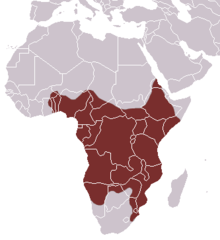Species of carnivore From Wikipedia, the free encyclopedia
The rusty-spotted genet (Genetta maculata),[2] also called panther genet and large-spotted genet, is a genet that is widely distributed in sub-Saharan Africa. It is considered common and therefore listed as Least Concern on the IUCN Red List.[1]
| Rusty-spotted genet | |
|---|---|
 | |
| Scientific classification | |
| Domain: | Eukaryota |
| Kingdom: | Animalia |
| Phylum: | Chordata |
| Class: | Mammalia |
| Order: | Carnivora |
| Suborder: | Feliformia |
| Family: | Viverridae |
| Genus: | Genetta |
| Species: | G. maculata |
| Binomial name | |
| Genetta maculata (Gray, 1830) | |
 | |
| Rusty-spotted genet range | |
The rusty-spotted genet has short whitish grey to pale yellow coloured fur with dark spots and a continuous dark line across the back. The spots of the upper two dorsal rows are round or square, brown in the center and darker outside. In head-to-body length it ranges from 42 to 52 cm (17 to 20 in). Its 40 to 53 cm (16 to 21 in) long tail is ringed and has a dark tip. Its feet are of the same colour as the fur. It weighs from 1.3 to 3 kg (2.9 to 6.6 lb).[3]
Research in southeastern Nigeria revealed that the rusty-spotted genet has an omnivorous diet. It feeds on rodents like giant pouched rats (Cricetomys), Nigerian shrew (Crocidura nigeriae), Temminck's mouse (Mus musculoides), Tullberg's soft-furred mouse (Praomys tulbergi), Peters's striped mouse (Hybomys univittatus), typical striped grass mouse (Lemniscomys striatus), red-eyed dove (Streptopelia semitorquata), common agama (Agama agama), Mabuya skinks, Myriapoda, spiders, Orthoptera and Coleoptera as well as eggs, fruits, berries and seeds.[4]
In 1830, John Edward Gray first described a rusty-spotted genet using the name Viverra maculata based on a zoological specimen that lived in the menagerie at the Tower of London.[5] In the 19th and 20th centuries, several taxonomists proposed the following species and subspecies for specimens obtained by natural history museums:[2]
Genetta letabae (Thomas and Schwann, 1906),[17] formerly considered a subspecies, is now thought to be a separate species.[18]
Seamless Wikipedia browsing. On steroids.